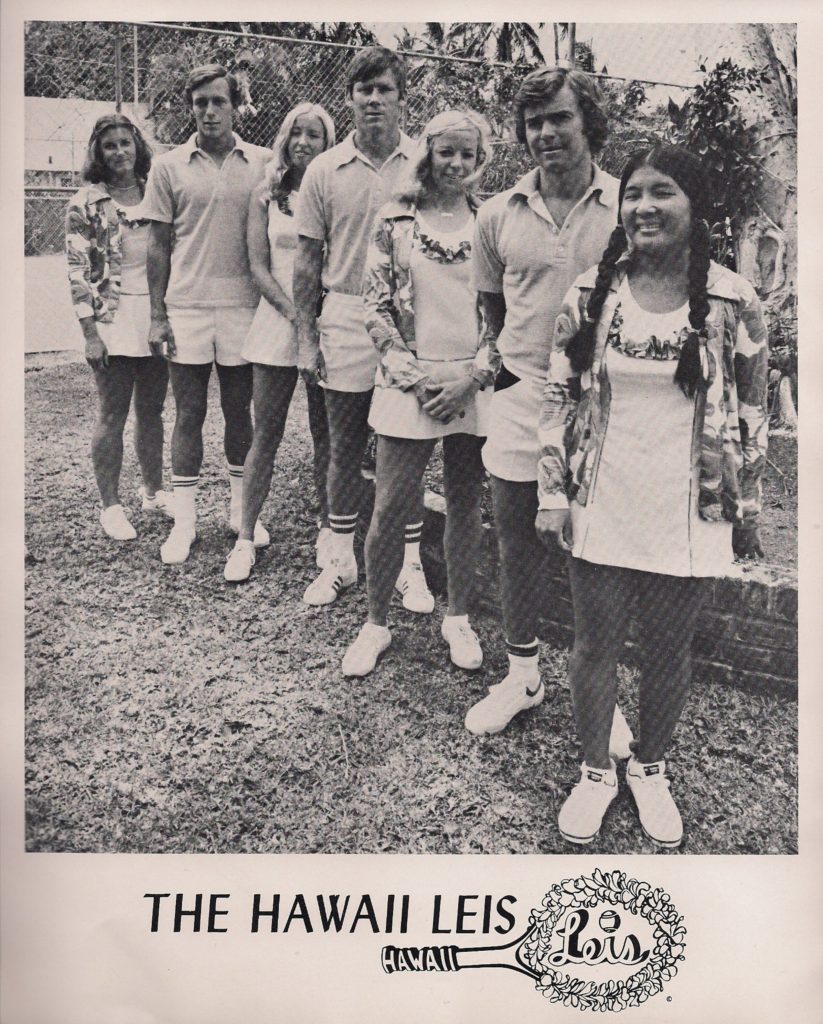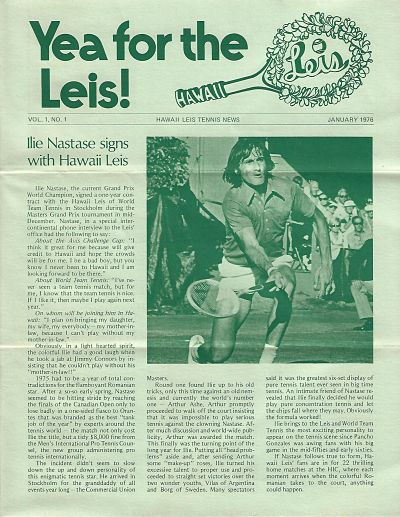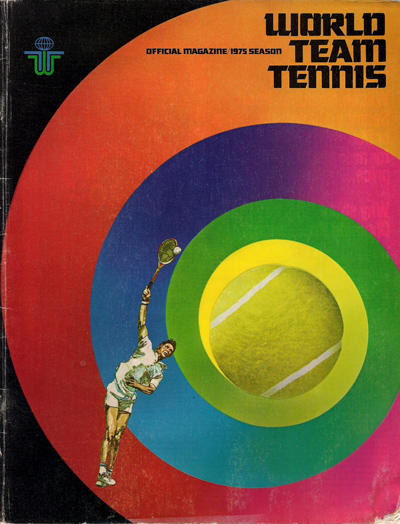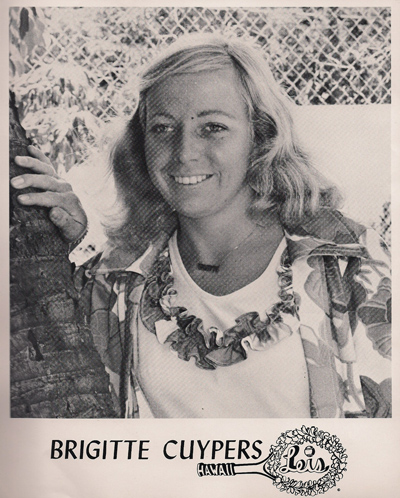Tombstone
Born: 1973 – World Team Tennis founding franchise
Moved: September 23, 1976 (Sea-Port Cascades)
First Match: May 7, 1974 (W 29-25 @ New York Sets)
Last Match: August 14, 1976 (L 24-19 @ San Diego Friars)
WTT Championships: None
Arena
Honolulu International Center (7,829)11976 World Team Tennis Media Guide
Opened: 1964
Marketng
Team Colors:
Conflicting info here…sources footnoted
Ownership
Owner: Don Kelleher
Background
World Team Tennis launched in 1974, intent on bringing top flight tennis out of the polite confines of the country clubs and into America’s raucous hockey and basketball palaces. Founders Dennis Murphy, Jordan Kaiser and Larry King (husband of league front woman Billie Jean King) sought to sell the product through a combination of star power, promotional gimmickry and nods to established team sports tropes.
Matches took place on candy-colored courts. Organizers encouraged fans to cheer loudly during rallies and to heckle opponents. World Team Tennis introduced a co-ed team sports league to the national sporting scene, drafting off the sensational publicity from the previous year’s “Battle of the Sexes” tennis exhibition between Bobby Riggs and King, the new league’s marquee female star. Top male players who signed on for 1974 included Jimmy Connors, Tom Okker and John Newcombe.
The Hawaii Leis were one of 16 WTT franchises that debuted in May 1974. The Leis were owned by Don Kelleher, a lumber salesman from San Rafael, California. Home matches took place at the 7,500-seat Honolulu International Center as well as the gym at Honolulu’s McKinley High School.
Innovative Rules
Teams were composed of three men and three women, playing two sets each of men’s and women’s singles and two sets of mixed doubles. (This format was quickly abandoned after early matches dragged on for up to four hours, replaced by a five-set format, featuring one set each of men’s and women’s singles, men’s and women’s doubles, and mixed doubles). The league featured a simplified “no-ad” scoring system meant to appeal to a broader swath of American sports fans, with 4 points winning a game, rather than the traditional Love-15-30-40 scoring familiar to tennis enthusiasts.
Some of the innovations didn’t sit well with Dennis Ralston, the U.S. Davis Cup captain and traditionalist player/coach of the Leis.
“Tennis is not like baseball,” Ralston complained to The Associated Press after one month of play in June 1974. “In Philadelphia and Baltimore, people would yell ‘Miss it!’ when you were serving and the announcers encourage them…pretty soon people will start throwing bottles.”
Ralston’s 1974 edition of the Leis finished last in World Team Tennis’ Pacific Division with a 14-30 record. In the 16-team league, only the 13-31 Buffalo-Toronto Royals fared worse. It would be the only time in the three-year history of the lowly Leis that another team finished with a grimmer record.
Superstar Signings
In April 1975, one month before the start of WTT’s second season, the Leis signed the 32-year old Australian star Margaret Court. Court won all four Grand Slam singles tournaments in 1970, becoming the first of only three women ever to do so.
One month later, the Leis got an unexpected opportunity to pair another marquee name with Court when the Houston E-Z Riders franchise abruptly folded on the eve of the season, leaving the league’s biggest male star without an employer. At age 30, Australian John Newcombe owned 23 Grand Slam titles in singles and doubles competition. In 1973, Newcombe had been the first male star to sign a contract with World Team Tennis. In doing so, he defied the Association of Tennis Professionals union which initially opposed its members joining the un-sanctioned league.
But Newcombe struggled through an injury-plagued campaign with the Leis in 1975. In a WTT match against the Pittsburgh Triangles in June, Newcombe tore cartilage in his knee, which caused him to miss Wimbledon. The 1975 Leis finished 14-30 for the second straight year, tied for the worst record in World Team Tennis. Neither Court nor Newcombe would return in 1976.
In December 1975, the Leis inked the combustible 29-year old Romanian Ilie Nastase to a one-year contract. The reported $125,000 deal was a coup for the league. The top male players had been somewhat slow to join the league up to this point. Nastase was a legitimate superstar and publicity magnet. Winner of the 1972 U.S. Open and 1973 French Open and the ATP’s #1 ranked male player for 1973.
Move To The Pacific Northwest & Aftermath
Despite Nastase’s presence, the Leis still averaged fewer than 3,000 fans per match during the first half of the 1976 WTT campaign. In early July, Kelleher announced that the team would move six late season matches to Portland, Oregon’s Memorial Coliseum and the Seattle Center Coliseum to test those markets for a potential relocation of the franchise in 1977.
The Leis continued to regress on the court. Hawaii finished dead last – again – in World Team Tennis’ 10-team format with a 12-32 record in 1977.
Kelleher made the move to the Pacific Northwest official in a September 1976 press conference, announcing that his club would be known as the Sea-Port Cascades in 1977 while splitting matches between Portland and Seattle.
World Team Tennis went out of business after the 1978 season.
A scaled back version of Team Tennis returned in 1981. The league later revived the “World Team Tennis” brand name and continues to play today, typically in country club settings rather than the large hockey and basketball arenas of the 1970’s.
Trivia
Former Hawaii Leis Margaret Court, Ilie Nastase and Dennis Ralston have all been inducted into the International Tennis Hall of Fame.
Downloads
1975 Leis Pre-Season Roster & Bios Press Release
1975 Hawaii Leis Roster & Bios
January 1976 Yea For The Leis! Team Newsletter
1975 World Team Tennis Season Advertising Rates Brochure
Links
###





2 Responses
Highly recommend the Wayback Machine blog pinged in the comment above. It really puts my Leis/Cascades article to shame, quite frankly, and features some wonderful photos from David Eskenazi’s archive. Check it out.